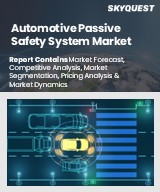
Report ID: SQMIG25AG2025
Skyquest Technology's expert advisors continuously track and analyze the latest developments and updates related to automotive passive safety system market. Our team of analysts stay abreast of all the recent news stories shaping the industry including new product launches by major companies, strategic partnerships, M&As, Patent filings and industry and regulatory developments.
REQUEST FOR SAMPLE
Global Automotive Passive Safety System Market size was valued at USD 28.01 Billion in 2023 and is poised to grow from USD 29.28 Billion in 2024 to USD 41.70 Billion by 2032, growing at a CAGR of 4.52% in the forecast period (2025-2032).
The global automotive passive safety system market is competitive with high entry barriers. Strong R&D capital requirements, rigorous safety standards, and dominance of existing players complicate market entry. Top players such as Autoliv, ZF Friedrichshafen, and Robert Bosch together command over 45% of the market share. Their strengths lie in widespread global reach, high R&D spend, and alliances with OEMs. Advanced airbag systems and smart seatbelts are innovations that add to their competitive advantage. Moreover, adherence to changing safety standards and an extensive distribution network support their market position. A new player can expand through investment in cost-saving safety technologies and strategic partnerships with OEMs. Expansion into emerging markets with changing safety regulations could also prove lucrative for expansion. 'Autoliv', 'ZF Friedrichshafen', 'Robert Bosch', 'Continental AG', 'Joyson Safety Systems', 'Hyundai Mobis', 'Toyoda Gosei', 'Ningbo Joyson Electronic', 'DENSO Corporation', 'Nippon Kayaku Co. Ltd'
SkyQuest study found that the consistent increase in world automobile manufacturing is a primary factor propelling the expansion of the automotive passive safety system market. In 2024, world automobile sales hit 74.6 million units, up 2.5% from 2023, while the car market of the EU expanded 0.8%, with overall sales reaching 10.6 million units. This accelerated speed of auto manufacturing benefits the demand for integrated passive protection features such as airbags, seatbelts, and crumple zones. As auto makers raise their production units and introduce new models in established economies and developing countries, installing complex passive protection systems is the prerequisite for compliance and customer faith.
Lightweight Material Adoption in Passive Safety Structures: There is increasing use of lightweight, high-strength materials including advanced composites, aluminum alloys, and thermoplastics in passive safety components. This development caters to the dual requirement of the automobile industry for increased crash performance and better fuel economy. Material innovation is aimed at designing components such as side impact beams, bumper reinforcements, and crash boxes that absorb increased energy with lower vehicle mass. This strategic transformation applies especially with the context of electrification of vehicles, wherein the weight must be minimized in order to balance out battery weight. Therefore, next-generation vehicle structure is being designed with new material integration into passive safety systems.
What makes the Asia Pacific Region a Hotspot for Investments in Automotive Systems?
Want to customize this report? This report can be personalized according to your needs. Our analysts and industry experts will work directly with you to understand your requirements and provide you with customized data in a short amount of time. We offer $1000 worth of FREE customization at the time of purchase.
Feedback From Our Clients

Report ID: SQMIG25AG2025
sales@skyquestt.com
USA +1 351-333-4748